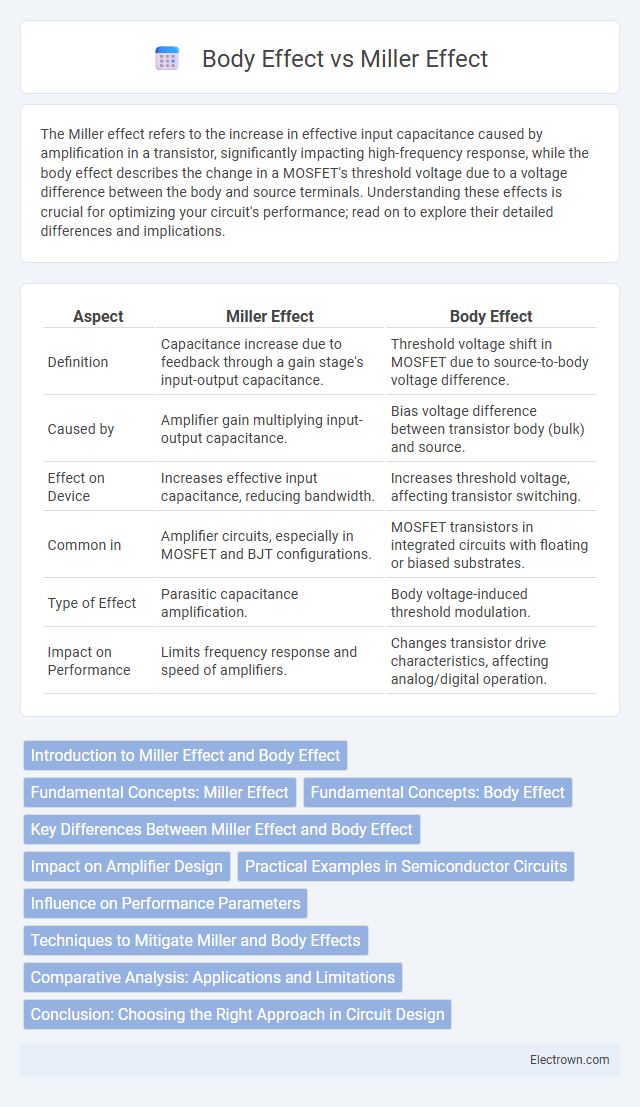The Miller effect refers to the increase in effective input capacitance caused by amplification in a transistor, significantly impacting high-frequency response, while the body effect describes the change in a MOSFET's threshold voltage due to a voltage difference between the body and source terminals. Understanding these effects is crucial for optimizing your circuit's performance; read on to explore their detailed differences and implications.
Table of Comparison
| Aspect | Miller Effect | Body Effect |
|---|---|---|
| Definition | Capacitance increase due to feedback through a gain stage's input-output capacitance. | Threshold voltage shift in MOSFET due to source-to-body voltage difference. |
| Caused by | Amplifier gain multiplying input-output capacitance. | Bias voltage difference between transistor body (bulk) and source. |
| Effect on Device | Increases effective input capacitance, reducing bandwidth. | Increases threshold voltage, affecting transistor switching. |
| Common in | Amplifier circuits, especially in MOSFET and BJT configurations. | MOSFET transistors in integrated circuits with floating or biased substrates. |
| Type of Effect | Parasitic capacitance amplification. | Body voltage-induced threshold modulation. |
| Impact on Performance | Limits frequency response and speed of amplifiers. | Changes transistor drive characteristics, affecting analog/digital operation. |
Introduction to Miller Effect and Body Effect
The Miller effect amplifies the input capacitance of an amplifier by reflecting the output-to-input capacitance, which can significantly reduce bandwidth in high-frequency circuits. The body effect refers to the change in threshold voltage of a MOSFET caused by a voltage difference between the body (substrate) and the source, impacting transistor performance and switching characteristics. Understanding these effects is crucial for optimizing your analog and digital circuit designs.
Fundamental Concepts: Miller Effect
The Miller effect describes the increase in effective input capacitance caused by a voltage gain across an amplifier's feedback capacitor, significantly impacting high-frequency amplifier performance. It occurs when the capacitance between the input and output terminals is multiplied by the gain, leading to bandwidth reduction and potential instability. This effect is critical in designing high-speed circuits and compensating frequency response in transistor amplifiers.
Fundamental Concepts: Body Effect
The body effect refers to the variation in a MOSFET's threshold voltage caused by the voltage difference between the transistor's body (substrate) and its source terminal. This effect influences the device's switching characteristics and overall performance by altering the threshold voltage, which impacts current drive and leakage currents. Understanding the body effect is crucial for accurate modeling and designing circuits, especially in analog and low-power applications.
Key Differences Between Miller Effect and Body Effect
The Miller effect amplifies the input capacitance in amplifiers by the feedback through a gain stage, significantly impacting high-frequency performance, while the body effect alters the threshold voltage of a MOSFET due to the voltage difference between the body and source terminals, influencing device switching characteristics. Your circuit's frequency response is primarily affected by the Miller effect, whereas the body effect modifies transistor behavior under different biasing conditions. Understanding these key differences aids in optimizing design for speed and threshold voltage control.
Impact on Amplifier Design
The Miller effect significantly influences amplifier bandwidth and stability by increasing the effective input capacitance, which imposes a trade-off between gain and high-frequency response. In contrast, the body effect alters the MOSFET threshold voltage and transconductance, impacting the amplifier's linearity and biasing conditions. Understanding both effects is crucial in amplifier design to optimize gain, frequency response, and power consumption, ensuring your circuit meets performance specifications.
Practical Examples in Semiconductor Circuits
In RF amplifiers, the Miller effect significantly impacts bandwidth by increasing the effective input capacitance, requiring careful compensation to maintain signal integrity. The body effect commonly influences MOSFET threshold voltage in analog circuits, altering transistor switching characteristics and necessitating design adjustments for consistent performance. Practical designs often mitigate the Miller effect by using cascode configurations, while the body effect is controlled through well biasing techniques in integrated circuits.
Influence on Performance Parameters
The Miller effect significantly impacts input capacitance, leading to reduced bandwidth and slower high-frequency response in amplifiers. The body effect increases threshold voltage, causing variations in drive current and transconductance, which can degrade switching speed and increase power consumption. Understanding these effects enables you to optimize transistor performance by carefully designing device geometry and biasing conditions.
Techniques to Mitigate Miller and Body Effects
Techniques to mitigate the Miller effect include using cascode configurations to reduce the effective input capacitance and employing neutralization methods to cancel feedback capacitance. To minimize body effect, designers often use body biasing to control the threshold voltage or implement triple-well structures that isolate the body from the substrate. Selecting these approaches enhances the performance and stability of analog circuits by controlling parasitic capacitances and threshold variations.
Comparative Analysis: Applications and Limitations
The Miller effect primarily impacts high-frequency amplifier design by significantly increasing the effective input capacitance, which limits bandwidth and gain in voltage amplifiers, whereas the body effect alters transistor threshold voltage due to substrate bias, affecting analog and digital circuit performance. Miller effect is crucial in applications requiring careful frequency response management, such as operational amplifiers and RF circuits, while the body effect is essential in low-voltage digital CMOS design and analog threshold voltage tuning. Limitations of the Miller effect arise in high-speed circuits needing minimal parasitic capacitance, while the body effect can introduce nonlinearities and variability in transistor behavior, challenging precise analog design.
Conclusion: Choosing the Right Approach in Circuit Design
Miller effect and body effect significantly influence transistor behavior in circuit design, affecting gain, bandwidth, and threshold voltage. You must evaluate the trade-offs: Miller effect impacts input capacitance and frequency response, while body effect alters threshold voltage and device switching characteristics. Selecting the right approach hinges on your specific application, balancing speed, power, and signal integrity requirements.
Miller effect vs body effect Infographic

 electrown.com
electrown.com